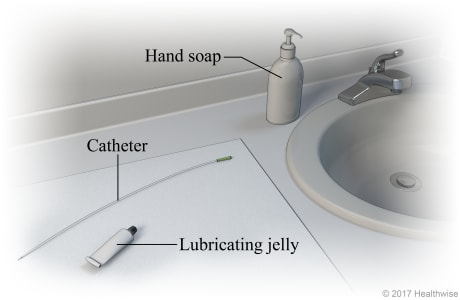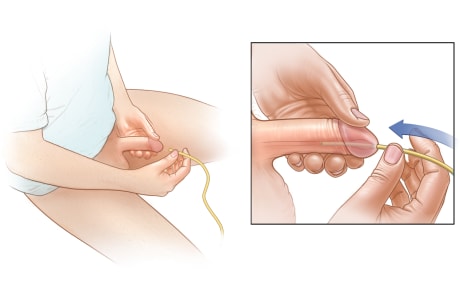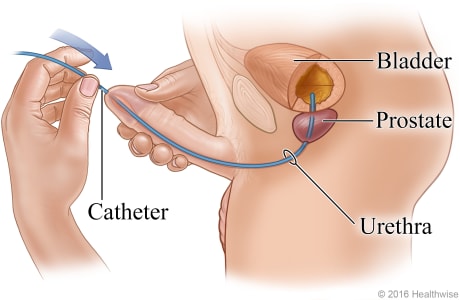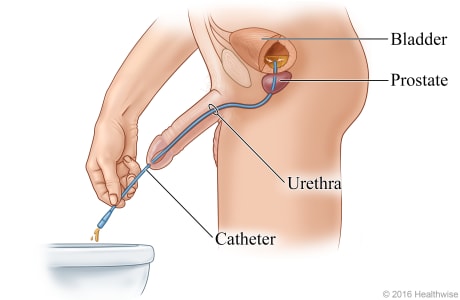Our Health Library information does not replace the advice of a doctor. Please be advised that this information is made available to assist our patients to learn more about their health. Our providers may not see and/or treat all topics found herein.
Topic Contents
Self-Catheterization (Male)
Overview
What is self-catheterization?
Self-catheterization is a way to regularly empty your bladder. You insert a catheter through the urethra into the bladder. The catheter is not permanent.
How do you use a catheter at home?
When you need to empty your bladder, try to urinate first, if you can, before you use the catheter.
Gather the supplies you need to insert the catheter.

You will need:
- The catheter.
- A container to hold the urine. (If you empty the urine right into the toilet, you won't need the container.)
- Lubricating jelly, such as K-Y Jelly, that dissolves in water. Don't use a petroleum jelly such as Vaseline.
You may want to use a clean washcloth or towel, plus a bag or plastic tub to hold the supplies.
Be sure to wash and dry your hands.
Find and clean the area around the urethra.

Place the urine container (if you are using one) between your legs.
Clean the end of your penis well with soap and water. (If you aren't circumcised, clean under the foreskin too.)
Spread the lubricating jelly on the tip of the catheter. Put the other end of the catheter over the toilet bowl or in the container to catch the urine.
Insert the catheter.

Gently insert the catheter into the urethra opening on the penis. Move the catheter in until urine begins to flow out. Then insert it about 1 inch more.
Let the urine drain into the container or the toilet.
Drain the bladder and remove the catheter.

Remove the catheter slowly. If you are using a disposable catheter, throw it away. If not, wash the catheter with warm, soapy water. Dry it and put it into a clean container.
Wash and dry your hands.
When should you call for help?
Call your doctor now or seek immediate medical care if:
- You have symptoms of a urinary tract infection. These may include:
- Pain or burning when you urinate.
- A frequent need to urinate without being able to pass much urine.
- Pain in the flank, which is just below the rib cage and above the waist on either side of the back.
- Blood or pus in your urine.
- A fever.
- Your urine smells bad.
- You can't pass any urine.
Watch closely for changes in your health, and be sure to contact your doctor if you have any problems.
Related Information
Credits
Current as of: November 15, 2023
Author: Healthwise Staff
Clinical Review Board
All Healthwise education is reviewed by a team that includes physicians, nurses, advanced practitioners, registered dieticians, and other healthcare professionals.
Current as of: November 15, 2023
Author: Healthwise Staff
Clinical Review Board
All Healthwise education is reviewed by a team that includes physicians, nurses, advanced practitioners, registered dieticians, and other healthcare professionals.
This information does not replace the advice of a doctor. Healthwise, Incorporated disclaims any warranty or liability for your use of this information. Your use of this information means that you agree to the Terms of Use and Privacy Policy. Learn how we develop our content.
To learn more about Healthwise, visit Healthwise.org.
© 1995-2024 Healthwise, Incorporated. Healthwise, Healthwise for every health decision, and the Healthwise logo are trademarks of Healthwise, Incorporated.

